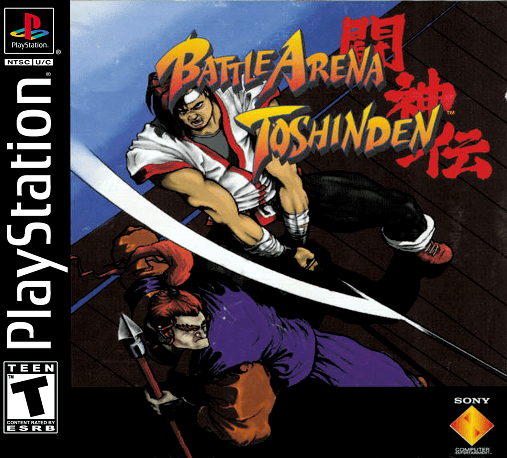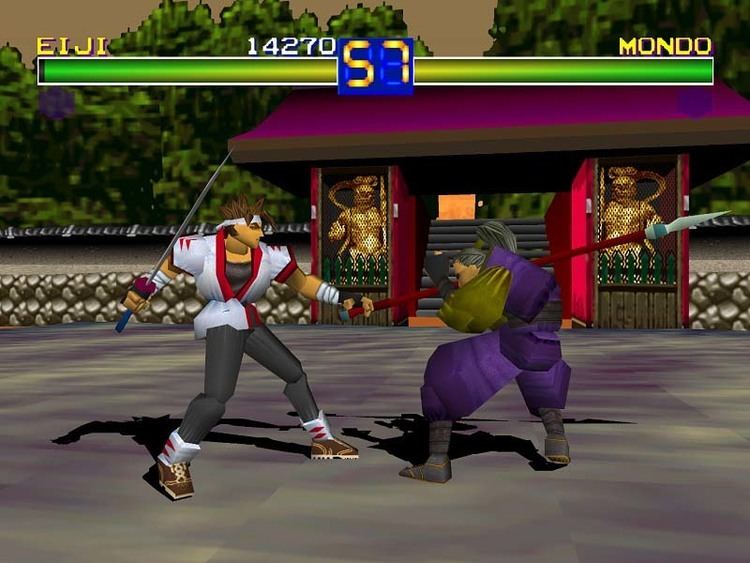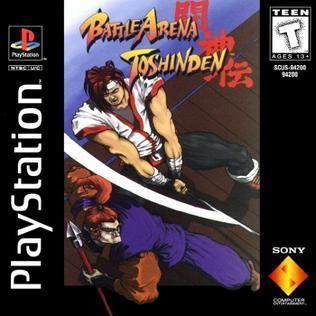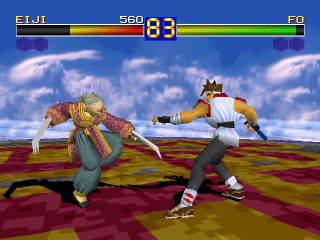Initial release date 1 January 1995 | Series Battle Arena Toshinden | |
 | ||
Release date(s) PlayStationJP: January 1, 1995NA: September 9, 1995EU: September 29, 1995SaturnEU: 1996NA: March 27, 1996JP: November 24, 1995Game BoyNA: November 1996EU: 1996JP: March 22, 1996PCNA: April 22, 1996 Mode(s) Single player, multiplayer Publishers Similar Battle Arena Toshinden games, Sega games, Fighting games | ||
Psx longplay 048 battle arena toshinden
Battle Arena Toshinden (バトルアリーナ闘神伝, Batoru Arīna Tōshinden) is a weapons-based fighting game developed by Tamsoft and published by Takara and Sony Computer Entertainment in 1995-1996 for the PlayStation, Sega Saturn, Game Boy, and PC. It was one of the first fighting games to boast polygonal characters in a 3D environment, and it is credited for taking the genre into "true 3-D" due to its introduction of the sidestep maneuver.
Contents
- Psx longplay 048 battle arena toshinden
- Battle arena toshinden eiji arcade playthrough
- Gameplay
- Plot
- Characters
- Release
- Reception
- Legacy
- References

The game was originally promoted as a PlayStation exclusive, with Sony initially promoting it as a "Saturn killer" (against Sega's Virtua Fighter), but it was ported to the Saturn with additional features less than a year later. Once fighting games like Tekken started emerging, Battle Arena Toshinden quickly declined in popularity, but still did spawn a series of sequels. It was the first 3D weapons fighter, and was succeeded in spirit by Soul Edge and other games of the genre.

Battle arena toshinden eiji arcade playthrough
Gameplay

Each character has his or her own unique set of basic moves, special attacks, and a desperation attack that can only be used when the player has low energy (around 10% or less). The player is able to move in 3D around the 3D arenas using the L/R shoulder buttons, which can be used to dodge projectile attacks, or get away from a dangerous spot.

Players move using the directional pad. Holding the backwards directional button allows the player to block basic attacks and reduces most of the damage from opponents' special moves. Players can also run by quickly tapping the forward directional button.
Plot
Eight traveling fighters, brought together by a common destiny, now meet at the Battle Arena Toshinden: a fighting tournament hosted by a mysterious organization known only as the "Secret Society". Many years have passed since this tournament, known only to those in the underworld, was last held. Some fighters have come for personal glory. Others have come to fight for those they love, but all will do their best to be victorious in this tournament which will decide their fortunes.
Characters
Initially playable characters:
Unlockable characters:
Release
The original PlayStation version was ported by Nextech/Sega to the Sega Saturn as Toh Shin Den S in Japan and as Battle Arena Toshinden Remix in the United States and Europe. A few new features were added, including an exclusive new character named Cupido and a story mode which enables the player to learn a few details about the characters' story backgrounds and the reasons of why they had entered into the tournament. Work on the Saturn port began while the PlayStation original was still in development.
Developed by Digital Dialect, the DOS port of the PlayStation version added an exclusive new character, Earthworm Jim, complete with his own unique arena music, but he only uses the moves of Rungo Iron. It also supports resolutions up to 640x480. The PC port uses the Japanese PlayStation version's voices and music in all regions, unlike the original PlayStation version.
The game was also ported to the Game Boy by Takara in 1996, titled Nettou Toshinden in Japan. The game is based mostly on the original PlayStation version, but it includes a slightly altered story mode and an early appearance of the character Uranus and the Battle Arena Toshinden 2 version of Gaia (without his armor).
Reception
Battle Arena Toshinden was critically acclaimed when released. It holds an average GameRankings score of 85% based on 2 reviews. Electric Playground gave the game a perfect score of 10 out of 10 in 1995. On release, Famicom Tsūshin scored the PlayStation version of the game a 30 out of 40, and gave it first a 9 out of 10 and later a 10 out of 10 in their Reader Cross Review.
GamePro reviewed the Japanese version of the game in early 1995 (prior to the PlayStation's launch in the U.S.). They remarked that the game is very impressive, and superior to Virtua Fighter in some aspects, but also flawed in several respects. They particularly praised the texture-mapped polygon graphics, original fighters, myriad moves, unique style of play, and the sidestep move, commenting that "The only problem with this slick defensive move is that from some viewing angles, the fighters obstruct the front of the screen, making it impossible to see where a move is coming from." Their review of the later U.S. release was also generally positive; they praised the graphics, stage design, playability, and dynamic camera, but criticized the game for being simplistic and easy, remarking that "This game relies more on flash than fighting." They summarized the game as "an enjoyable fight." Next Generation also reviewed the game prior to the PlayStation's U.S. launch. They commented that while the gameplay lacks originality and good reaction speed, the 3D aesthetics and graphics make it a much more powerful experience to play than a typical 2D fighter. However, they concluded that the game loses "by a hair" when compared to its rival, Virtua Fighter.
The four reviewers of Electronic Gaming Monthly gave the game a rave review, chiefly praising the character design, graphics, and special moves. Maximum made note of the graphical and gameplay innovations such as gouraud shading, rotational backgrounds, dramatic camera angles, and the sidestep. However, they remarked that the poor quality directional pad on the original PlayStation controller "just isn't built for taking diagonals and quarter circle rolls", making it irritatingly difficult to pull off special moves. Though they assessed the game as good overall, they advised gamers to instead hold out for the PlayStation port of Tekken, which they felt to be far superior in every respect. IGN gave the game a score of 7 out of 10 in 1996, by which time it was seen as slow and "not as impressive" as the more recent Tekken 2, though they praised Toshinden for important innovations to the fighting game genre, such as taking "the fighter into true 3-D" and "one little move" that "changed the fighter forever" with the introduction of sidestep movement. Dragon gave the game 3 out of 5 stars. In an early 1995 interview, when asked which PlayStation game he was most impressed with so far, Ken Kutaragi answered Battle Arena Toshinden.
Battle Arena Toshinden was awarded Best Fighting Game of 1995 by Electronic Gaming Monthly. However, during their 200th issue leadup in 2005, they ranked Battle Arena Toshinden as their single most overrated game. They explained that it "was 3D, it was flashy--Battle Arena Toshinden was exciting and new. But later Namco showed us what really could be done with 3D fighting on the PlayStation (Tekken, Soul Blade). (...) But is it actually good? Oh God, no."
The Sega Saturn version was not as well-received as the PlayStation original. The four reviewers of Electronic Gaming Monthly complained of the fact that the graphics were not improved from the PlayStation version, and felt that the game was overshadowed by the recent release of Battle Arena Toshinden 2. While Rob Allsetter of Sega Saturn Magazine greatly praised the visuals of the game and judged the button configuration to be superior to that of the PlayStation version, he criticized the "slow" gameplay and the limited variety of moves, concluding that Battle Arena Toshinden is "still decent enough, but ... lacks the speed and depth of its more illustrious successors." A reviewer for Next Generation said that the visuals of the Japanese release were not up to par with those of the PlayStation version, and advised Saturn owners to wait for the U.S. release in hopes that Sega of America would fix the graphical shortcomings. GamePro's Tommy Glide commented that there is not enough additional content in the Saturn version and the graphics do not look as smooth as the PlayStation version's, assessing it as overall "a poor conversion." Maximum's Rich Leadbetter stated that it fails to recreate the graphical effects of the PlayStation original, which he opined were the only saving grace of an extremely dull game. He held the additional character and the PAL conversion's lack of borders to be its only advantages over the PlayStation version.
Legacy
During the late 1990s, the game was followed by three sequels, Battle Arena Toshinden 2, Battle Arena Toshinden 3, and Toshinden 4, as well as a spin-off game Battle Arena Nitoshinden. An anime adaptation of the same title was also released in 1996. Eiji appeared as a secret guest character in the Sega Saturn game D-Xhird, released by Takara in 1997.
A new Tōshinden (闘真伝) game was unveiled in Weekly Famitsu in 2008. It was developed by DreamFactory for the Wii and has no connection to the previous games' storyline. It is titled War Budokai, roughly translated as War Tournament. While previous Toshinden installments feature mainly weapons-based combat, War Budokai features hand-to-hand combat alongside the weapons-based battles. A total of 8 characters were unveiled in official illustrations. The game was released in Japan on December 10, 2009.
